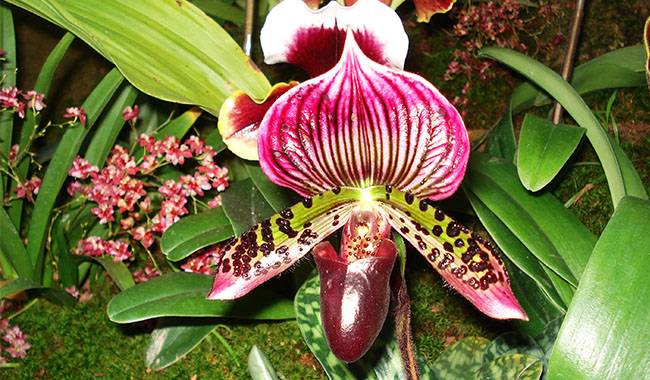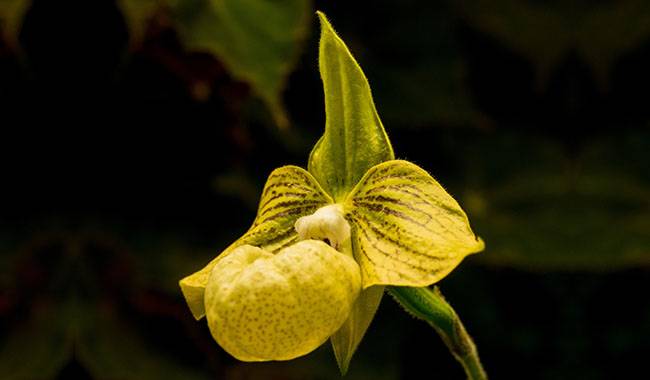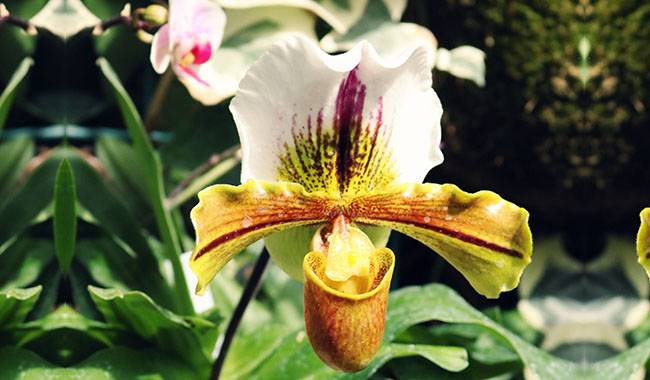
Today, Paphiopedilum flowers have been almost replaced by the hardy Paphiopedilum. Luxuriously flowering, small, and very versatile, Paphiopedilum is orchids that can be enjoyed indefinitely. Nostalgic and fashionable at the same time, they remain unfamiliar plants to many, shrouded in myth and legend. In practice, they are much friendlier than their royal reputation would suggest. paphiopedilum will not bloom without proper care, conditions are not standard, but they have adapted well to living rooms. You will learn how to grow Paphiopedilum plants in the ThumbGarden article.
DESCRIPTION OF PAPHIOPEDILUM (VENUS SLIPPER) PLANT
Paphiopedilum (Venus Slipper), as opposed to the beautiful nickname “cannibal flower”, is a name that is not familiar to every florist. Named after the ancient Roman goddess, orchids became a legend long before their counterparts became almost mandatory to grow, and a large number of unpretentious hybrids have made the dream of orchids a reality for many enthusiasts.
Paphiopedilums (Paphiopedilum, officially “Paph”) are terrestrial, symbiotic, medium-sized orchids of the Cypripedium (Slipper orchids) family. Considering the length of the flowering stems, the maximum height of the plant is only 8-20 inches (20-50 cm).
However, Paphiopedilum is certainly not inconspicuous. The rhizomes are very short and all Paphiopedilum have very strong well-developed fleshy roots. They develop in the typical way of symbiotic orchids – the “rosette” flowers only once, release a flower stalk, and then do not flower again.
The succession rosettes are picked up by daughter plants growing at the base of the parent rootstock and replacing them. This plant is never grown as a single specimen, but only in families or groups of three rhizomes that continually produce new offspring.
The typical orchid-like strap-like leaves with strong spikes and central folds look very neat and stiff. Leaves can reach 23 inches (60 cm) in length and are limited to a few times smaller in some species. They are monochromatic, bright green, or marbled and sit in a peculiar bilateral rosette. Paphiopedilum leaves grow quite vigorously and turn yellow and brown before wilting.
In Paphiopedilum, a smaller signal or stop leaf appears in the center of the rosette just before the flowering stems are released, seemingly to herald the beginning of the flowering period.
PAPHIOPEDILUM (VENUS SLIPPER) FLOWERING
The flowering stems of Paphiopedilum develop from the center of the rosette. They are usually fairly straight and smooth, longer than the leaves.
Named for the swollen shape of its large lips, Paphiopedilum does resemble the elegant Paphiopedilum. it is the only orchid that has three “petals” in its flowers.
The upper sepal is rightly compared to sail; it is very large, bright, patterned, and slightly angled to protect the lips. The shape and size of the upper sepals are always different from the two lateral sepals, and neither of them bears any resemblance in color to the lips. The patterns are contrasting and striking. ‘Paphiopedilum’ has three anthers at a time – a sterile, shield-like one and two sturdy ones.
This is a spring-flowering orchid. The natural flowering time for orchids is when daylight hours increase. However, depending on conditions and care, Paphiopedilum flowering can be delayed indefinitely, postponed, or continue indefinitely.
The palette of Paphiopedilum flowers includes all known hues and halftones in all parts of the spectrum except blue. Whites, yellows, pinks, purples, violets, greens, browns – the shades and combinations of most polychromatic flowers are endlessly varied. And the beauty of the patterns – from tiny spots to blotches, stripes, and ripples – is amazingly varied.
VARIETIES OF PAPHIOPEDILUM PLANTS
This orchid is rightly considered to be the most diverse of all. However, all Paphiopedilum stand out in some special way. They differ in the conditions and care required and in the many nuances of cultivation, but the key to identifying the different groups and classes lies in their flowers. This is the beginning of determining what this orchid needs in order to bloom to its full potential in your home.
Based on their flowering patterns, Paphiopedilum is divided into three broad groups – single-flowered, multi-flowered, and continuously flowering species and varieties.
Monoflora Paphiopedilum
This is the largest group of species and varieties, consisting mainly of “wild” or species plants, simple and complex “Paphiopedilum” hybrids, from which plant breeding began.
In fact, it is the oldest Paphiopedilum group in the culture. The name of the group clearly indicates the main characteristics of the plant – produces very large, but only one, very rare – two flowers on a flowering stem, which after flowering can be simply cut off. The duration of flowering is quite long. The flowers can last up to 3 months.
Among the species of this group the following stand out.
Paphiopedilum insigne is the least desired Paphiopedilum plant. Its beige salad flowers are fragrant and bloom in winter.
Paphiopedilum conco-bellatulum is one of the most beautiful mottled orchids. The delicate, snow-white flowers, with almost black dots on all-around petals, seem to be a miracle of artificial creation.
Paphiopedilum delenatii and its numerous ornamental forms with delicate pink and white, and very large, rounded lateral petals.
There is one exception to the “rule” of this group-Paphiopedilum concolor, capable of producing three delicate pink flowers with rounded petals with fine black markings.
The first of the “Paphiopedilum” hybrids is the unpretentious golden-white, wavy, and aqua paphiopedilum harrisianum (Paphiopedilum harrisianum – Paphiopedilum villosum x Paphiopedilum barbata).
But everyone knows the single-flowered Paphiopedilum flowers from the appearance and relative unpretentiousness of the complex American hybrid cultivars. Although they have only one flower, they are up to 8 inches (20 cm) in diameter, have a very delicate mottled pattern, large round-veined lateral petals, and contrasting colors. A typical example is the “Maudiae” variety, whose upper petals are white.
Multiflora Paphiopedilum
This is a group with inflorescence clusters containing up to 10 flowers. The flowering time of these orchids is the same as that of the single-flowered orchids – up to 3 months.
The favorite species of this group of Paphiopedilum are the colorful species of orchids (the names usually refer directly to the original species and shades of color – ‘Delenatii White’, ‘Delenatii Pink’, ‘Delenatii Gold’, but there are some other species as well.
- Paphiopedilum ‘Deperle’ (Paphiopedilum delenatii x Paphiopedilum primulinum) has delicate porcelain-white flowers with elongated petals.
- Paphiopedilum rothschildianum with moustache-like protruding thin lateral petals, red lip, and striped sails.
Three species have dangling spiral leaves with long purple lateral petals.
- Paphiopedilum philippinense with striped yellow and white.
- Striped beige – brown – purple striped Paphiopedilum sanderianum.
- White-green Paphiopedilum parishii.
Continuous-flowering Paphiopedilum
This is a group of relentless or continuous-flowering hybrid cultivars with up to 30 alternate flowers on their stems due to breeding. These Paphiopedilum always have 1-2, rarely 3 on top.
The ability of each flower to last longer than a month allows a plant, even on a single flowering stem, to extend its flowering period by 2 years or more. The longer the duration, the longer the flower stems, and the smaller the flowers themselves.
Without exception, all the spinulose plants are hybrids, obtained mainly by crossing Paphiopedilum glaucophyllum, Paphiopedilum liemianum, Paphiopedilum royalis (Paphiopedilum Victoria-regina), and Paphiopedilum primulinum.
The most popular and “reliable” of the Paphiopedilum Pinocchio species is Pinocchio, with shortened, almost linear, spotted lateral petals, swollen lips, and feathery, large upper petals.
GROWTH CONDITIONS OF INDOOR PAPHIOPEDILUM PLANTS

Whether they are heat-loving or hardy, whether they bear single flowers or inflorescences, Paphiopedilum is so diverse that there are simply no general rules for their cultivation. When buying popular varieties of Paphiopedilum plants, it is worth clarifying all the nuances of care and cultivation conditions. After all, the plants are so independent that there are simply no uniform norms. They need a separate approach.
Lighting and placement
Unlike many orchids that bloom well, Paphiopedilum adapts well to different light conditions, especially if you let them gently adapt to new conditions during the dormant period.
They can bloom in bright light as well as light shade, and are happy with any kind of diffuse light. And like all orchids, they do not tolerate strong shade or direct sunlight. The latter is particularly dangerous when combined with heat.
However, multi-flowered Paphiopedilum, especially species rather than hybrids, require stronger light than single-flowered and invert plants and can only flower in autumn and winter under strong artificial extra light.
Comfortable light levels for almost all Paphiopedilums are 2100 to 2600 Lux and 12 to 14 hours of daylight.
Venus Paphiopedilum is light-dependent, extending towards the light source. Outside of the flowering period, they rotate regularly to ensure the even development of bilateral leaf clusters. However, the plants should not be moved during the germination and flowering period.
The best location for Paphiopedilum is an eastern windowsill or anywhere with similar light intensity-from scattered light from a southern or partially southern window to artificially dim lighting indoors.
Temperature control and ventilation
“Paphiopedilum” Venus Slipper flowers prefer to be cool; they do not tolerate cold or heat and, like all orchids, prefer diurnal fluctuations in temperature (especially the rotating varieties). Their optimal cultivation range depends on whether the variety is thermophilic or cold-tolerant.
Most single-flowered and multi-flowered Paphiopedilum plants of hybrid origin are hardy and well suited to -moderate indoor conditions, 59-68 °F (15-20 °C) at night and 53-64 °F (12-18 °C) in winter during active growth from March to October.
The more colorful the leaves of a species are, especially if they are decorated with markings, the more the orchid likes heat. Like all Spinning Paphiopedilum, these varieties do not tolerate temperatures below 64 °F (18 °C), preferring to grow between 64-71 °F (18-22 °C).
They have a short dormancy period, just after flowering, and may not be cool, but it is best to keep the minimum temperature to 60 °F (16°C).
Drying should be very gentle but regular. Plants can be placed on a balcony or in a sheltered spot in the garden, as long as the light is controlled and too bright is avoided. Paphiopedilum does not tolerate proximity to heating and air conditioning systems.
HOW TO TAKE CARE OF PAPHIOPEDILUM PLANTS AT HOME

Despite the difficulties of site selection and requirements, Paphiopedilum is one of the easiest and most special orchids to care for. They can even be watered normally as long as the minimum care requirements are met.
Watering and air humidity
Paphiopedilum needs very adequate watering during its peak growth period. It is one of the most moisture-loving orchids.” Paphiopedilum” orchids prefer light, constant moisture in the soil, and do not tolerate completely dry soil; some species will even die when dry.
The substrate should not be kept moist; it should be dried to light moisture content, but not completely dry, depending on the color change of the roots in the clear container and the tactile (touch, feel) sensation in the ceramic pot. Excess water should be drained within no more than 5 minutes after watering.
Instead of soaking, the classic method of the watering can be used, although it is safer because it soaks the substrate evenly.
The way of watering in winter depends on the type of plant. Single-flowered and multi-flowered Paphiopedilum prefer to reduce the amount of watering by a few times. Rotating Paphiopedilum should be watered neatly, except after the last flower has opened and before growth begins when it is gently wiped dry.
Watering Paphiopedilum plants have one key characteristic: they do not tolerate excessive wetting of the above-ground parts and waterlogging at the base of the leaves, so water carefully around them or do not flood the rosette from below when soaking.
Paphiopedilum should be watered with rainwater or its artificially filtered counterpart. Many older species will tolerate plain clarified water, but it is best not to experiment with newer, fancy water.
This orchid does not like very high humidity and prefers to grow indoors at 30 to 60 percent humidity (increasing humidity to the upper standard is desirable during leaf and cotyledon growth). Yes, spray with “mist” (warm water), especially in summer and in high temperatures, and wipe the leaves regularly with a slightly damp sponge. Dust buildup on the leaves is unacceptable
Fertilizer and fertilizer composition
This orchid should be fertilized year-round, except during the dormant and blooming periods. Plants do not like sudden changes in substrate nutrient levels, so instead of regular fertilization, fertilize consistently by adding a small amount of fertilizer to the water when watering.
With a normal fertilization program, fertilize every 3 weeks during periods of vigorous growth; for permanent fertilizers, divide the dose by the number of waterings (the standard number of waterings per week is 3).
Only orchid-specific fertilizers should be used on Paphiopedilum. this orchid does not tolerate chemical fertilizer components or experiments with organic matter.
Pruning and shaping Paphiopedilum
These procedures are limited to the removal of dried flower stems and foliage (as with all orchids, it is best not to rush the natural development process).
Transplanting, containers, and substrates
Repotting of Venus talcum should only be done when there is simply no space for the root system to develop. Paphiopedilum should be replanted after 2-3 years at the earliest. However, it is best to monitor the development and condition of the root system. Any signs of decay, mold, salt crystals, and other deposits are a signal for urgent replanting.
For Paphiopedilum, partial replacement of the substrate is acceptable in years when replanting is not required, or if the quality and structure of the substrate are maintained. This is more frequent than replanting – every six months, taking care not to come in contact with the roots and removing the only loose soil and the top layer of contamination.
The best time for transplanting is spring, from late March to early May.
These orchids require typically specialized containers: orchid pots with multiple openings in the bottom and double containers that allow all roots to breathe evenly and minimize the risk of overwatering the substrate.
Paphiopedilum grows better in clear containers, ceramic or glass, rather than plastic containers. Transparent containers allow a free view of the root system. They do not grow in ordinary houseplant containers and are not suitable for growing on wood blocks.
Use a standard orchid substrate for growing Paphiopedilum. a composite substrate is superior to a bark-only substrate. Acceptable additives are charcoal, perlite, coarse sand, coarse coconut soil, and expanded clay.
Some Paphiopedilum species require careful pH control, but they usually grow well in weakly acidic and neutral soils. When purchasing a substrate, it is a good idea to check that “Paphiopedilum plants” are on the list of recommended species.
After transplanting, plants should not be watered, but only raised to 60-70% humidity and controlled at about 68 °F (20°C). The first watering is done after 5-8 days.
Pests and problems of growing Paphiopedilum
This orchid is extremely sensitive to cold and improper care. When Paphiopedilums are too wet and too cold, they will drop their buds and may stop flowering.
Paphiopedilum often signals problems with substrate changes in the foliage. If the leaves turn brown without yellowing and the black color spreads from the top to the border, the plant has too much salt in the substrate or a fungal disease.
Common diseases are gray mold, which causes flowers to fall off, and various types of root rot and fungal infections. All diseases should be controlled in the first instance by emergency replanting and the use of fungicides, and if severe, by removing damaged roots and pruning the plant substantially.
These orchids are occasionally infested with scabies, mealybugs, and spider mites.
Paphiopedilum plant propagation
This is one of the easiest orchids to propagate. When adult shrubs grow too large or you want to expand your collection, you can simply separate them.
It is wise to propagate Paphiopedilum plants instead of constantly adding containers for them because in very large groups the risk of infestation of the plants also increases. The minimum number of dividers – 2-3 rhizomes.







